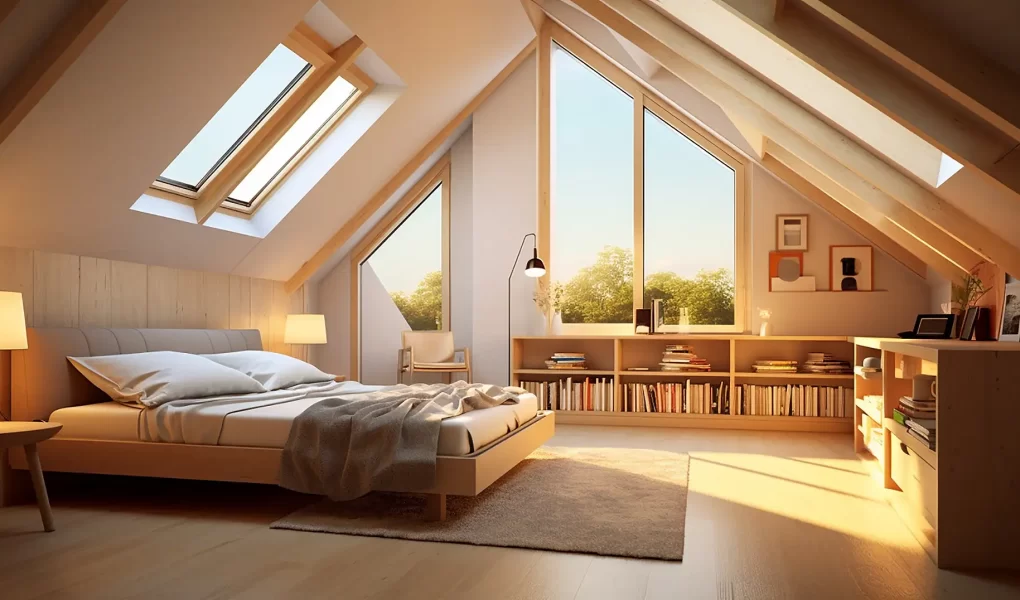Converting an attic into a functional room is a fantastic way to maximize the space in your home. Whether you need an extra bedroom, a home office, or a cozy retreat, an attic conversion can provide the perfect solution. This guide will walk you through the steps necessary to turn your attic into a beautiful and usable space.
1. Assess the Feasibility of the Project

Before diving into the renovation, it’s crucial to determine if your attic can be converted into a room.
Structural Integrity
- Consult a Structural Engineer: Ensure the attic floor can support the weight of the new room, including furniture and occupants.
- Check Roof Structure: Verify that the roof is in good condition and can be modified without compromising structural integrity.
Building Codes and Permits
- Local Building Codes: Familiarize yourself with local building codes and requirements for attic conversions.
- Obtain Permits: Secure necessary permits for the renovation to avoid legal issues.
Headroom
- Minimum Height Requirement: Most building codes require at least 7 feet of headroom over 50% of the usable floor area.
- Sloped Ceilings: Plan the layout to accommodate sloped ceilings and make the most of the available space.
2. Plan the Layout and Design
Effective planning is key to a successful attic conversion.
Determine the Room’s Purpose
- Bedroom, Office, or Playroom: Decide how you will use the space to inform design and layout decisions.
- Storage Needs: Plan for built-in storage solutions to make the most of the space under the eaves.
Create a Floor Plan
- Measure the Space: Accurately measure the attic to create a detailed floor plan.
- Plan Layout: Position furniture and functional areas to maximize the usable space and ensure comfortable movement.
Lighting and Ventilation
- Natural Light: Incorporate skylights or dormer windows to enhance natural lighting.
- Artificial Lighting: Plan for sufficient lighting fixtures, including task lighting and ambient lighting.
- Ventilation: Ensure proper ventilation to maintain air quality and prevent moisture buildup.
3. Insulate and Install Utilities
Proper insulation and utilities are essential for comfort and functionality.
Insulation
- Roof and Walls: Insulate the roof and walls to maintain temperature and reduce energy costs.
- Floor Insulation: Consider insulating the floor for soundproofing and additional temperature control.
Electrical Wiring
- Hire an Electrician: Ensure safe and compliant electrical installation for lighting, outlets, and other electrical needs.
- Plan for Outlets: Position electrical outlets strategically for convenience and accessibility.
Heating and Cooling
- HVAC Extension: Extend existing HVAC systems or install a separate unit to ensure the room is comfortable year-round.
- Radiators or Space Heaters: Consider additional heating options if extending HVAC is not feasible.
4. Construct and Finish the Space
With the planning and utilities in place, you can proceed with the construction and finishing touches.
Flooring
- Subfloor Preparation: Ensure the subfloor is level and sturdy.
- Install Flooring: Choose durable and attractive flooring materials such as hardwood, laminate, or carpet.
Walls and Ceilings
- Drywall Installation: Install drywall on the walls and ceiling, ensuring proper finishing and smoothing of seams.
- Paint and Finish: Choose light and neutral colors to enhance the sense of space and light.
Windows and Doors
- Install Windows: Add windows or skylights for natural light and ventilation.
- Doors: Install doors that complement the style of the room and provide privacy.
5. Furnish and Decorate
The final step is to furnish and decorate your new attic room to make it inviting and functional.
Furniture Selection
- Scale and Proportion: Choose furniture that fits the space without overwhelming it.
- Multi-Functional Pieces: Opt for furniture with built-in storage or convertible features to maximize space.
Storage Solutions
- Built-In Storage: Utilize the space under the eaves for built-in cabinets, shelves, or drawers.
- Free-Standing Units: Incorporate free-standing storage solutions that complement the room’s design.
Decorative Elements
- Textiles and Accessories: Add rugs, curtains, and cushions to create a cozy atmosphere.
- Personal Touches: Decorate with personal items, artwork, and plants to make the space uniquely yours.
Tips for a Successful Attic Conversion
Budget Wisely
- Set a Budget: Establish a realistic budget for the project, including a contingency fund for unexpected expenses.
- Prioritize Spending: Allocate funds to essential structural work and utilities before focusing on aesthetics.
Hire Professionals
- Architect and Contractor: Consider hiring professionals for design and construction to ensure quality and compliance.
- Specialized Trades: Utilize electricians, plumbers, and HVAC specialists as needed for specific tasks.
Safety Considerations
- Fire Safety: Install smoke detectors and ensure compliance with fire safety regulations.
- Egress Windows: Ensure there are adequate egress windows for emergency exits.




